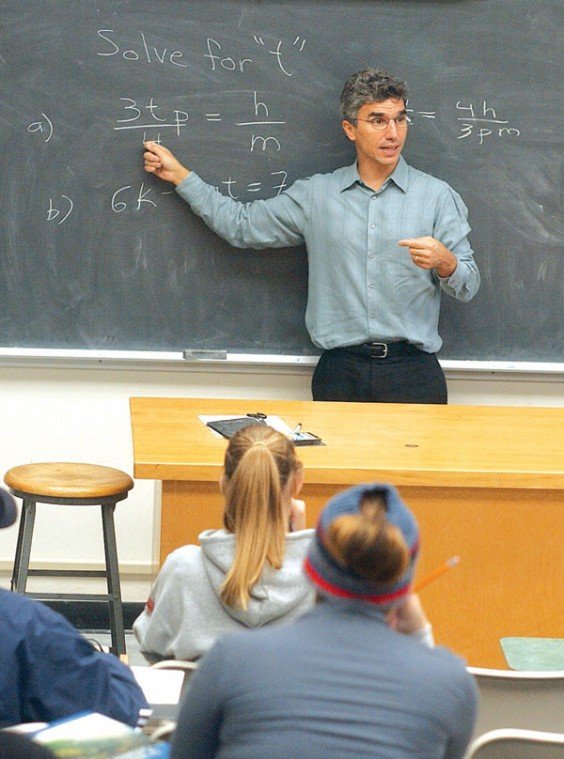Nestled snugly against the hills in southwest Gilroy, Gavilan
College exudes a quiet ambiance. Students taking a break between
classes soak up the morning sun from a gazebo in the middle of
campus. Not far away, birds chirp and bees buzz lazily past a pond
that reflects the blue, cloud speckled sky.
Nestled snugly against the hills in southwest Gilroy, Gavilan College exudes a quiet ambiance. Students taking a break between classes soak up the morning sun from a gazebo in the middle of campus. Not far away, birds chirp and bees buzz lazily past a pond that reflects the blue, cloud speckled sky.
But appearances can be deceiving. Within the peaceful, nature-influenced campus, things are happening that indicate this 85-year-old college is already the school of the future for South Santa Clara and San Benito counties.
Keeping up with local students’ needs – from vocational programs to high-tech training to university transfers – is Gavilan’s mission, according to college President and District Superintendent Steve Kinsella.
“As we look forward at all our objectives, my goal that I’ve talked to everyone on campus about is we need to make Gavilan the college of choice for our service area,” Kinsella said, “so (students) don’t feel they’re getting something better by going north or south. We want to make sure that they’re getting the same thing here.”
The college will continue to add transferable courses in all areas to ease students’ transition to a four-year college or university. Currently, 46 percent of Gavilan’s classes are transferable to the California State University and University of California systems, Kinsella said. About 32 percent of classes are vocational and 10 percent are remedial.
Not only will population growth in South Valley send more students Gavilan’s way, but Gov. Arnold Schwarzenegger is putting a renewed state focus on the community college system.
“We were intended to provide those first two years, and what has happened over a period of time is more students have just gone directly into the UC and CSU, and it’s far more expensive for the state to offer those first two years than what we’re able to provide,” Kinsella said.
The cost is burdensome to students, too. Community colleges cost a fraction of what the university systems charge.
“What I want students to be comfortable with is knowing that what they get here from us is equal to what they get anywhere else,” Kinsella said. “And it is 100 percent transferable to UCs and CSUs, so it really doesn’t matter if they do their first two years here or if they do it at a CSU or UC. It has equal value on their transcripts.
“Even though it’s a public system of higher ed, if we offer certain things, we want them to choose us because of our course offerings, because of the quality of instruction and because it’s local.”
Course offerings at Gavilan include more than the usual general education subjects, too, leaning toward the high-tech. A Cisco networking academy and digital media program help prepare students for entry-level jobs in those fields or, ideally, the pursuit of a bachelor’s degree.
The Cisco networking academy, three semesters long, is designed to give students Internet technology skills. The courses in networks and router technology also prepare students to test for the Cisco Certified Network Associate certificate.
The program, launched in 1997, and certification are intended to be part of a bachelor’s degree study and isn’t necessarily Cisco Systems-specific. The skills taught in the courses created by the San Jose-based Internet networking company are applicable to any company’s products and technologies.
Computer technology is the backbone of digital media courses offered at Gavilan since 2001. In 2002, the college created a certificate program in areas like digital imaging, digital art and Web page production. Classes teaching digital photography, interactive animation, Photoshop and computer art can even go toward earning an associate’s degree in digital media in the near future.
Associated Student Body President Simon Cooke said Gavilan’s high-tech programs will continue to anchor what has become a key player in the South Valley community.
“I can definitely see it being an influential college,” he said of Gavilan’s near future. “I can imagine its course offerings expanding, I can imagine its departments getting a little bigger, so there will be more classes for students to take.”
As early as next year, those classes could include bioscience, as the college’s Small Business Development Center works to promote the biotech industry in Gilroy by establishing educational and training opportunities for future employees.
Thanks to a $900,000, five-year grant, Gavilan College is leading an effort to make this agriculture-and-high-tech area the biotech headquarters for a region that stretches from San Jose to the Nevada border.
By establishing educational opportunities at Gavilan and in nearby high schools, Rich Gillis, director of the Small Business Development Center, says biotech firms will be more likely to settle in Gilroy and draw from a qualified work force.
“We think there’s a lot of educational support, and we want to exploit that to encourage (industry),” Gillis said. “They have to have trained employees, and at the same time, you can’t have one without the other.”
Gavilan is responding to another Valley trend: the growth of the health care industry, particularly nursing.
According to a recent survey of the Silicon Valley economy, health services was the only industry to add jobs from the second quarter of 2002 to the second quarter of 2003. Local hospitals reported a shortage of nurses and community colleges awarded 60 percent more certificates in that field.
“That’s not just a regional concern; that’s a national concern,” Kinsella said. “To have health care professionals available to provide quality health care services to our rising population. We are looking at expanding the allied health program considerably.”
Growth at Gavilan extends beyond adding more class offerings in Gilroy. With two satellite campuses in Hollister and Morgan Hill, the college will continue bringing tailored education directly to the neighborhoods it serves.
“We anticipate about a 5 percent growth each year,” said Marty Johnson, vice president of instructional services. That translates to about 250 additional students a year.
Between the current semester and next fall, 75 class sections will be added to serve as many students as possible. In Morgan Hill and Hollister, more and more daytime classes are being scheduled because the evening classes that make up the bulk of those areas’ offerings are full.
“That’s where the demand is, and we anticipate an even greater demand there if the bond is successful,” Johnson said. The bond passed by a narrow margin March 2. “Then we’ll have many options to be able to use more space.”
Years down the road, with the addition of permanent locations in Morgan Hill and Hollister, Gavilan may become a three-campus community college district.
“I see an emerging campus in Hollister,” Trustee Mark Dover said. “I think in the next five years, you’ll see a second (full) campus in Hollister.”












